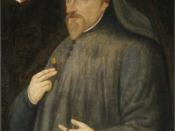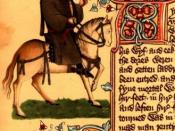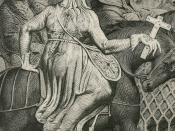The Canterbury Tales, written by Geoffrey Chaucer, is a collection of tales that branch from a main story line. Each tale was written by fictional characters of different rank and status in English medieval society. These tales offer excellent insights into various aspects of medieval society and culture, and the evolution of this society to our current one.
The Canterbury Tales begins at the Tabard Inn, near London. The narrator joins a group of twenty-nine pilgrims, all traveling to Canterbury to visit the shrine of martyr St. Thomas Becket. These pilgrims are colorfully described in the Prologue. They include a Knight, a Squire, a Yeoman, a Prioress, a second Nun, a Monk, a Friar, a Merchant, a Clerk, a Man of Law, a Franklin, a Weaver, a Dyer, a Carpenter, a Tapestry-Maker, a Haberdasher, a Cook, a Shipman, a Physician, a Parson, a Miller, a Manciple, a Reeve, a Summoner, a Pardoner, the Wife of Bath, and the Narrator.
Chaucer offers a glimpse of medieval society and culture in the Prologue. Medieval society revolved around a class and feudal system. The main classes in this system included the royalty, the clergy, and the laborers. Chaucer provides a critical yet comedic commentary on each member of the tale. From the noble Knight to the meager Reeve, all classes of medieval society are clearly represented in the Canterbury Tales, with the exception of the royal class. Chaucer intentionally omitted this class, illustrated by there being no social rank higher than the Knight. The author may have been critical of authority figures and wanted to heighten the nature and role of the common man. Chaucer's guildsmen in the story represent the gradual emergence of the middle or bourgeois class, which along with the Black Death, would lead to the decline of feudalism.


